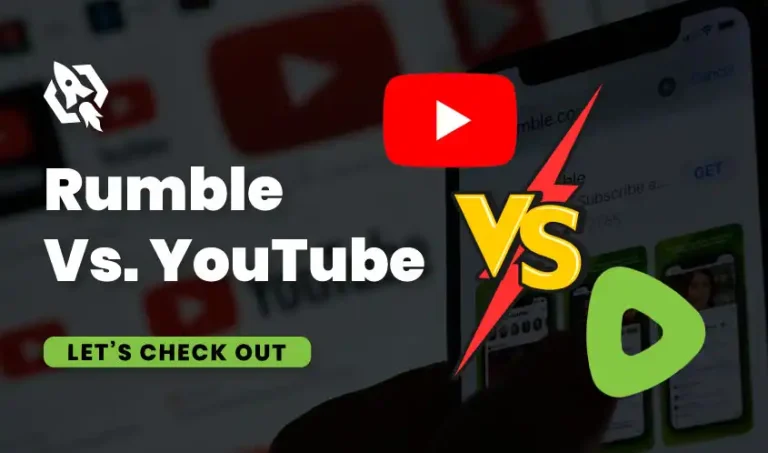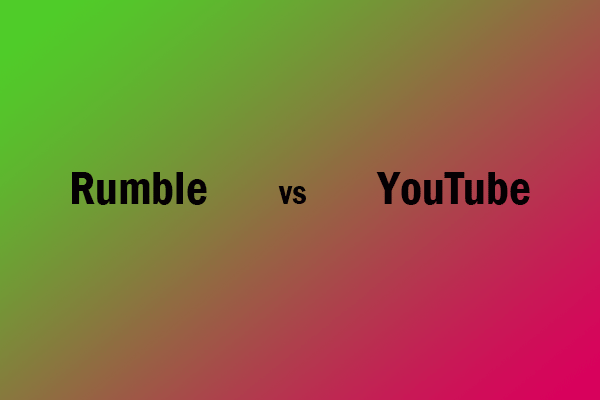In the world of online content creation, understanding how earnings work is crucial for creators looking to thrive. With platforms like Rumble and YouTube leading the charge, it’s essential to dive into how these platforms reward their creators. From ad revenue to subscription models, each platform has its unique approach. Let’s explore the fundamentals of creator earnings and see how Rumble stacks up against YouTube.
Overview of Rumble's Monetization Model

Rumble is carving out its niche in the crowded video-sharing landscape, primarily by offering creators a more favorable monetization model. Here’s a closer look at how Rumble stands out:
- Ad Revenue: Rumble shares ad revenue with content creators, allowing them to earn a percentage of the money generated from ads displayed on their videos. This percentage can be as high as 60-80% depending on the agreement.
- Rumble’s Revenue Share: Unlike YouTube, which typically takes a significant cut of ad revenue, Rumble emphasizes a creator-first approach. This means that a greater portion of the earnings goes directly into the pockets of the creators.
- Monetization Options: Rumble offers several avenues for monetization, including:
- Direct Payments: Creators can earn money directly from Rumble based on their video views and engagement metrics.
- Licensing Opportunities: Rumble allows creators to license their content to media outlets, providing an additional revenue stream.
- Custom Deals: Creators can negotiate custom monetization deals, which can further enhance their earnings potential.
- Ease of Access: Rumble’s platform is designed to be straightforward, enabling creators to start earning without complex eligibility requirements. New creators can monetize their content more quickly compared to YouTube’s often lengthy approval process.
- Focus on Views: Rumble rewards creators based on views, making it possible for a video to earn money even if it doesn’t go viral. This is a significant advantage for smaller creators who may not have as large an audience yet.
- Community Support: Rumble promotes a supportive environment for creators, often highlighting new and emerging talent. This focus on community can lead to increased visibility and, consequently, higher earnings opportunities.
- Cash Bonuses: Rumble occasionally offers cash bonuses or contests that incentivize creators to produce high-quality content or engage with trends.
- Subscription Services: Creators can also set up subscription-based models on Rumble, allowing their most dedicated fans to support them directly.
In summary, Rumble’s monetization model is designed to empower creators, providing them with multiple revenue streams and a more favorable share of earnings compared to traditional platforms like YouTube. As more creators seek alternatives to mainstream platforms, Rumble’s approach may very well attract a new wave of talent eager to maximize their earnings.
Also Read This: When Will My Hero Ultra Rumble Come Out? Expected Release Timeline
3. Overview of YouTube's Monetization Model

YouTube has built a robust monetization model that has evolved significantly since its inception. At its core, YouTube allows creators to earn money primarily through advertising revenue. This is facilitated by the YouTube Partner Program (YPP), which gives creators access to various monetization tools. To join YPP, creators must meet certain criteria: they need at least 1,000 subscribers and 4,000 watch hours in the past 12 months.
Once part of YPP, creators can earn money through:
- Ad Revenue: This is the primary source of income, where ads are shown before, during, or after videos. Creators earn a share of the revenue generated from these ads.
- Channel Memberships: Fans can become paying members of a channel for exclusive perks like badges, emojis, and special content.
- Super Chat and Super Stickers: During live streams, viewers can pay to have their messages highlighted, providing another income stream for creators.
- YouTube Premium Revenue: Creators earn a portion of the subscription fees from YouTube Premium members who watch their content.
Moreover, YouTube allows creators to integrate affiliate marketing and merchandise sales directly into their channels, giving them additional ways to monetize their audience. The potential earnings can be substantial, but they also depend heavily on audience engagement, niche, and the number of views.
It’s important to note, however, that the platform takes a cut of the revenue generated. Typically, creators receive around 55% of ad revenue, while YouTube retains about 45%. This revenue-sharing model can sometimes lead to frustration among creators, especially those who feel their content is unfairly demonetized or restricted. Nevertheless, YouTube remains a dominant platform for creators due to its vast audience reach and established infrastructure.
Also Read This: Where Will Royal Rumble 2025 Take Place? Event Location Revealed
4. Direct Earnings Comparison Between Rumble and YouTube
When comparing earnings between Rumble and YouTube, it’s essential to consider their different models and how they impact creators. Rumble's approach is distinct, offering a more straightforward revenue-sharing system that appeals to many creators.
| Feature | YouTube | Rumble |
|---|---|---|
| Revenue Share | Approx. 55% to creators | 70% to creators |
| Ad Revenue | Ads shown before, during, and after videos | Ads shown primarily before videos |
| Memberships | Channel memberships available | No membership feature |
| Content Ownership | YouTube retains rights to content | Creators retain full rights |
| Live Streaming | Available with Super Chat | Limited live streaming features |
As you can see, Rumble offers a more creator-friendly revenue share, allowing creators to keep a larger portion of their earnings. This model attracts those who seek better profitability without the extensive requirements of YouTube's monetization process.
However, while Rumble may provide better earnings per video, YouTube's massive audience and diverse monetization options give it an edge in overall earning potential for many creators. For instance, a creator with a niche audience may find that YouTube's ad revenue outstrips Rumble's earnings, despite the higher percentage on Rumble.
Ultimately, the choice between Rumble and YouTube for creators often boils down to individual goals, audience size, and content type. As both platforms continue to evolve, understanding these differences is crucial for creators looking to maximize their earnings.
Also Read This: Why Is My Car Rumbling When I Accelerate?
5. Factors Affecting Creator Earnings on Each Platform
When it comes to creator earnings, both Rumble and YouTube present unique landscapes influenced by several factors. Let's break down what affects how much creators can actually earn on these platforms.
1. Monetization Models: YouTube primarily operates on ad revenue, meaning creators earn money based on the views their videos receive. This can fluctuate based on the type of ads shown and the audience's geographic location. Rumble, on the other hand, has a different approach; it allows creators to earn money through licensing their videos to media outlets and advertisers, in addition to ad revenue. This can create opportunities for bigger payouts, especially for viral content.
2. Audience Engagement: Viewer engagement plays a crucial role. YouTube's algorithm favors videos with high watch time, which can lead to increased ad revenue. On Rumble, engagement can also drive licensing deals, as more views can lead to more media interest. Creators who engage with their audience through comments and live sessions typically see better earnings.
3. Niche and Content Type: Certain niches perform better on one platform than the other. For instance, tech reviews or gaming content might thrive on YouTube due to a larger audience base, while Rumble may be more favorable for political commentary or unique news stories that draw media attention.
4. Consistency and Frequency of Uploads: Regular uploads can significantly affect earnings. YouTube tends to reward consistent creators through its algorithm. Meanwhile, on Rumble, consistent high-quality content can lead to licensing opportunities, boosting potential income.
5. Platform Policies and Changes: Both platforms frequently update their policies, which can impact earnings. YouTube has faced scrutiny over ad policies, leading to changes that can affect revenue. Rumble's growing model may also adapt, presenting both challenges and opportunities for creators. Staying informed about these changes is essential for maximizing earnings.
6. Case Studies: Successful Creators on Rumble and YouTube
Examining real-life case studies can shine a light on how creators successfully navigate these platforms. Let’s look at a few notable examples from both Rumble and YouTube.
Rumble Success Story: Take Dan Bongino, a political commentator who successfully transitioned to Rumble. With a strong following, he leveraged Rumble’s licensing model effectively, earning significant revenue through media licensing and ads. His content aligns perfectly with Rumble’s audience, proving that understanding the platform’s strengths can lead to financial success.
YouTube Success Story: On the flip side, we have PewDiePie, one of the most successful YouTubers of all time. With millions of subscribers and a steady stream of content, he capitalizes on YouTube's ad revenue and sponsorship deals. His ability to engage with his audience and adapt content strategies has kept his earnings soaring. PewDiePie’s journey illustrates how consistency, creativity, and audience connection can maximize earnings on YouTube.
Shared Insights: Both creators illustrate that knowing your audience is key. Bongino found a niche that resonated with Rumble’s user base, while PewDiePie continuously adapts his content to keep his audience engaged. Lessons learned from these case studies highlight the importance of platform synergy—creating content that not only fits the creator’s style but also aligns well with platform characteristics.
In summary, whether you're looking to earn on Rumble or YouTube, understanding the specifics of each platform and seeing what strategies have worked for others can guide you toward success!
 admin
admin








